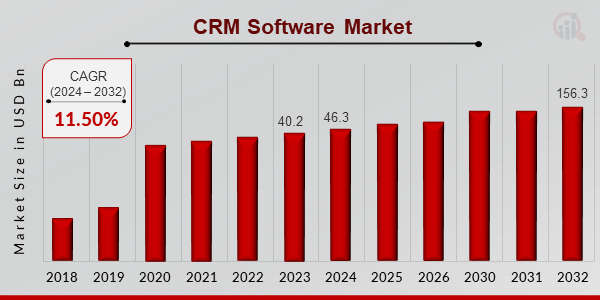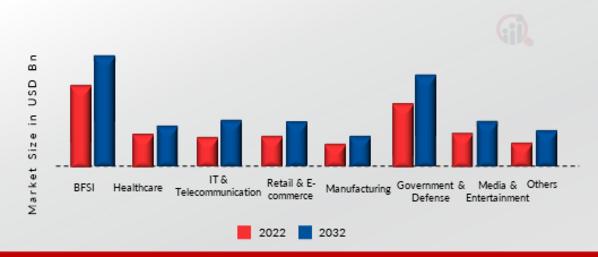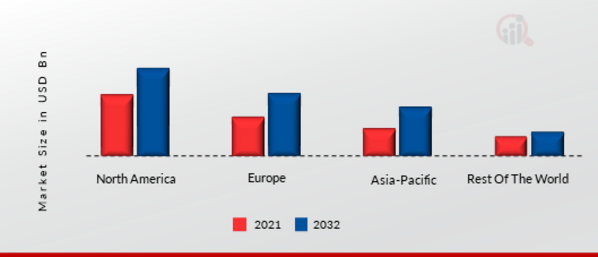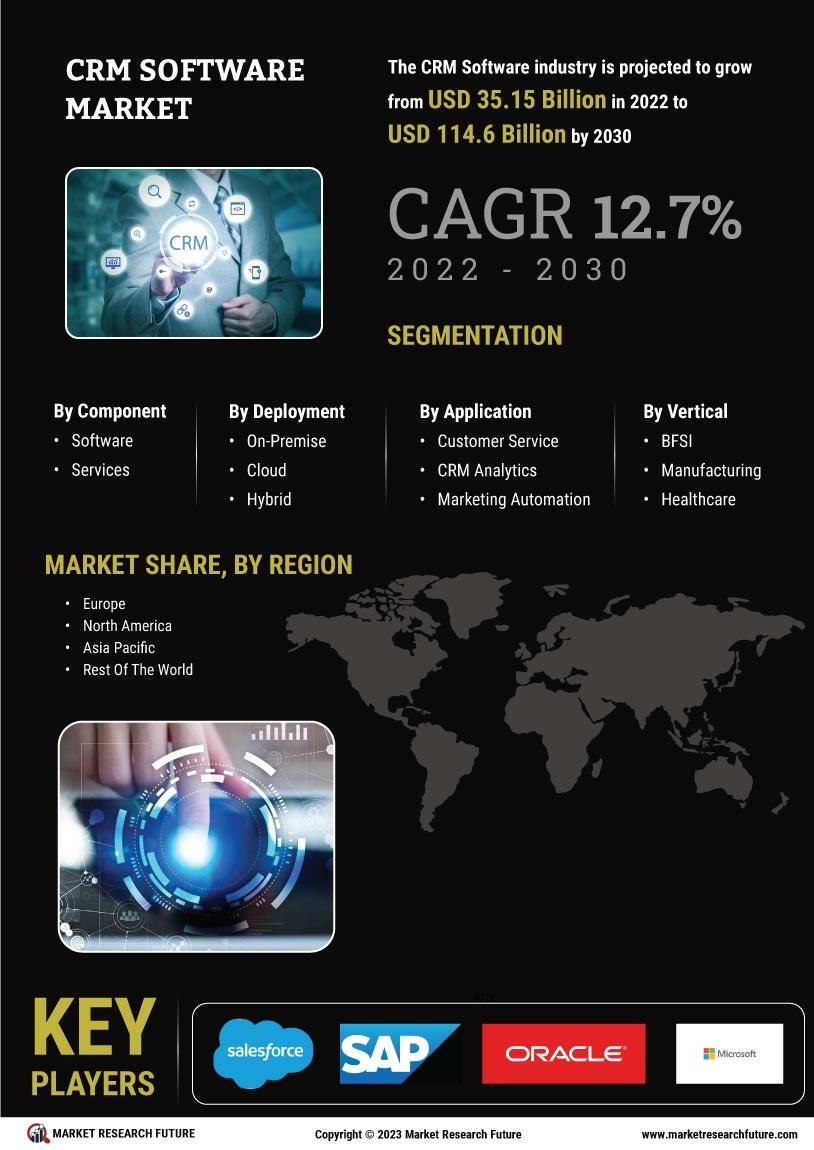CRM Software Market Summary
As per MRFR Analysis, the CRM Software Market was valued at USD 40.2 Billion in 2023 and is projected to grow to USD 156.3 Billion by 2032, with a CAGR of 11.50% from 2024 to 2032. The market is driven by the increasing integration of AI technologies, rapid digital transformation across industries, and the growing demand for enhanced customer relationship management solutions. The software segment dominates the market, while the cloud deployment model is expected to witness the fastest growth due to its cost-effectiveness for small and medium-sized enterprises. The BFSI sector leads the verticals, reflecting a shift towards digital banking and customer-specific software solutions.
Key Market Trends & Highlights
Key trends influencing the CRM Software Market include technological advancements and sector-specific demands.
- Integration of AI in CRM systems is enhancing customer experience and driving market growth.
- Cloud deployment is the largest segment, expected to grow rapidly due to low IT infrastructure costs.
- The BFSI sector dominated the market in 2021, driven by increasing digital banking services.
Market Size & Forecast
2023 Market Size: USD 40.2 Billion
2024 Market Size: USD 46.3 Billion
2032 Market Size: USD 156.3 Billion
CAGR (2024-2032): 11.50%
Largest Regional Market Share in 2021: North America.
Major Players
Major players include Salesforce.com, SAP AG, Oracle Corporation, Microsoft Corporation, Adobe Systems Inc, and IBM Corporation.
CRM or customer relationship management software refers to strategies or technologies a company uses to analyze customer interactions throughout the consumer lifecycle. CRM software is designed to compile information about customers across different channels with the basic goal to maintain business relationships. It helps the companies to stay connected with their customers and improve profitability and also helps in streamlining work processes.
Figure 1: CRM Software Market Size, 2024-2032 (USD Billion)

Source: Secondary Research, Primary Research, MRFR Database, and Analyst Review
CRM Software Market Trends
Integration of Artificial Intelligence
Artificial intelligence (Al) applications are expanding quickly on a scale. Similarly to this, there is a growing demand to integrate Al with CRM systems to enhance the customer experience. Deep learning, machine learning, and natural language processing-based CRM software aid businesses in comprehending the psychological condition of their customers. By managing and delivering solutions to customers using this data, the software helps businesses forge close bonds with their customers. For instance, Salesforce Einstein and Zoho CRM's Zia both provide an Al-powered CRM that collects client data using speech technologies. Additionally, bots and virtual assistants employ this technology to reduce human error and offer automatic responses to emails, reports from customers, data collection, and other duties. The use of Al technology will therefore probably lead to an expansion in the market's size in the near future.
Rapid Digital Transformation
The use of cutting-edge technology across corporate sectors to enhance operations and customer value delivery is anticipated to fuel demand for CRM solutions. To increase their regional presence, businesses also plan to execute business strategies and market trends. This method helps businesses to offer a better client experience after data analysis.
CRM Software Market Segment Insights
CRM Software Component Insights
The market segmentation, based on Components, includes Software and Services. The software segment holds the majority share in 2021 of the market. This is due to a growth in the use of CRM software by businesses to obtain a strategic and competitive edge and outperform their rivals in terms of client retention. Additionally, it enables the industrial vertical to quickly win over new clients and keep them on board for an extended period, which fuels market expansion.
CRM Software Deployment Insights
Based on Deployment, the market segmentation includes On-Premise, Cloud, and Hybrid. The Cloud segment is accounted for the largest share of the market. Since cloud implementation requires no investment in IT infrastructure because all data is housed on cloud servers, the market for customer relationship management software in small and medium-sized businesses is anticipated to develop at the fastest rate in the next few years.
CRM Software Application Insights
Based on Application, the market segmentation includes Customer Service, Customer Experience Management, CRM Analytics, Marketing Automation, Salesforce Automation, and Others. The Customer Service segment is accounted for the largest share of the market. The software immediately analysis and improve customer service and operates in solving customer problems.
CRM Software Vertical Insights
Based on Vertical, the market segmentation includes BFSI, Healthcare, IT & Telecommunication, Retail & E-commerce, Manufacturing, Government & Defense, Media & Entertainment, and Others. The BFSI segment dominated the market in 2021. The BFSI industry is gradually becoming more digital, which calls for the creation of customer-specific software. To attract and keep devoted consumers, growing online banking services are also anticipated to enhance demand for management software.
Figure 2: CRM Software Market, by Vertical, 2021 & 2030 (USD Billion)

Source: Secondary Research, Primary Research, MRFR Database, and Analyst Review
CRM Software Regional Insights
By region, the study provides market insights into North America, Europe, Asia-Pacific, and the Rest of the World. North America has dominated the market share. As of the increasing use of emerging technology such as machine learning and industrial automation, as well as a significant shift in business toward digital transformation. North America is also becoming a hub for various industrial verticals such as IT and Telecom, healthcare, and the energy and utility sector. This industry vertical has a big client base, which will need the use of customer relationship management software.
Further, the major countries studied in the market report are The U.S., Canada, Germany, France, the UK, Italy, Spain, China, Japan, India, Australia, South Korea, and Brazil.
Figure 3: CRM SOFTWARE MARKET SHARE BY REGION 2021 (%)

Source: Secondary Research, Primary Research, MRFR Database, and Analyst Review
Asia-Pacific is anticipated to experience the highest growth the market forecast period. This is because organizations in this region are investing heavily in this market to maintain growth and boost productivity. The significant trend toward digital transformation, cloud deployment and technical advancement among small and medium-sized organizations, and ongoing modernization of marketing and sales strategy in emerging nations are other aspects that significantly contribute to the market growth.
CRM Software Key Market Players & Competitive Insights
The major market players are investing a lot of money in R&D to expand their product lines, which will spur further market growth. With significant market development such as new product releases, increased investments, and collaboration with other organizations, market participants are also undertaking various strategic activities to expand their presence. To grow and thrive in a market climate that is becoming more competitive and growing, competitors in the CRM Software industry must offer affordable products.
Manufacturing locally to cut operating costs is one of the main business tactics manufacturers use in the CRM Software industry to benefit customers and expand the market sector. Major market players, including IBM, SAP AG, Oracle Corporation, Microsoft Corporation, Adobe Systems Inc, and others, are attempting to increase market demand by funding R&D initiatives.
Oracle is a corporation that offers cloud-based applications and platform services. It works in three divisions: Cloud and License, Hardware, and Services. Through its cloud and licensing products, the Cloud and License business advertises, sells, and delivers a variety of enterprise applications and infrastructure technologies. The Hardware division includes hardware support along with enterprise hardware solutions and related software such as Oracle Engineered Systems, servers, storage, industry-specific hardware offerings, operating systems, virtualization, and management. Consulting and advanced customer service are included in the Services section.
Technology firm SAP creates business application software. It provides services for many different company sectors, such as enterprise resource planning and finance, customer relationship management and customer experience, network and expenditure management, digital supply chain, human resources, and employee engagement. The business provides services to the energy and natural resource, consumer, public, financial, automotive, aerospace, and defense industries, among others.
Key Companies in the CRM Software market include
CRM Software Industry Development
- In November 2023, Zolution and Creatio mobilized a partnership with the aim of providing the latter’s no-code platform to Zolution’s clients in an attempt to automate their workflows. This should help its clients improve their CRM approaches and increase the interaction of clients with the firm as a whole.
- In September 2023: Sonoma Valley Vintners and Growers announced that it had entered into a comprehensive working agreement with Singapore Telecom to set a foundation for building an expanded range of business for the association by positioning istele & video as the key elements. The two companies plan to roll out Ai based service and Genesys, with which employees can get enriched and also customers through using the bots, and communication channels, and data from Salesforce Service Cloud which they integrate in CX Cloud.
- In July 2023, Salesforce announced a strategic investment in Office Depot’s modernization program designed to strengthen the company’s service and communications capabilities with the most important clients. The Sales Cloud solution developed by Tercas will assist the United States Council in such aspects as the efficient allocation of territories, compensation, capacity as well as quota.
- In July 2023, Zaitoun Investment and Creatio deployed the MVP of a transformative supply chain financing platform that enables companies to consolidate their sales processes and increase their cash flows through optimal management of their supplier relationships. With no-code self-serve solutions from Creatio and integration of marketing, sales and service optimization practices by CVM People, effective customer retention becomes a reality for medium and larger size businesses in the UK.
- In July 2023, xAfrica and Creatio decided to join hands with the aim of providing xAfrica with the necessary resources that will help increase the effectiveness and capacity of the organizations that it serves in important business sectors while enhancing the performance of such businesses. xAfrica is a business consultancy and service provider that specializes in the areas of sales enablement, prospecting, brand awareness, revenue management, and compliance.
- In July 2023, Copper CRM launched new features to its list views experience with the purpose of optimizing how the data is interpreted and the overall feel and look of the application. Additionally, the company has introduced a variety of design elements to facilitate movement about the platform and expanded the width of the record preview side panel. There is also a feature for in-line editing to streamline the workflow and a function for creating ‘active list’ or ‘basic list’ so as not to have to use tags.
- In June 2023, SugarCRM and sales-i jointly announced a partnership regarding the enhancement of B2B sales performance within the manufacturing, wholesale, and distribution sectors with the support of AI and machine learning that would further boost the understanding of the customers, analytics and intelligence. As a result, the partnership would immediately enable every customer to use their sales analytics across teams, branches and products, consolidating sales in manufacturing and logistics industries.
- In May 2023, Insightly announced the launch of its ‘Insightly Modern CRM Checklist’ so that high growing companies should be able to evaluate their software platforms. The company wishes to assist businesses comprehend how CRM software has adapted to changes in clients’ demands over the years, and ask questions concerning mobile accessibility, extensibility, integration, authentication, cost, and many more.
CRM Software Market Segmentation
CRM Software Component Outlook
CRM Software Deployment Outlook
CRM Software Application Outlook
CRM Software Vertical Outlook
CRM Software Regional Outlook
| Attribute/Metric |
Details |
| Market Size 2023 |
USD 40.2 Billion |
| Market Size 2024 |
USD 46.3 Billion |
| Market Size 2032 |
USD 156.3 Billion |
| Compound Annual Growth Rate (CAGR) |
11.50% (2024-2032) |
| Base Year |
2021 |
| Market Forecast Period |
2024-2032 |
| Historical Data |
2018 & 2020 |
| Market Forecast Units |
Value (USD Million) |
| Report Coverage |
Revenue Forecast, Market Competitive Landscape, Growth Factors, and Trends |
| Segments Covered |
Component, Deployment, Application, Vertical, and Region |
| Geographies Covered |
North America, Europe, Asia Pacific, and Rest of the World |
| Countries Covered |
The U.S, Canada, Germany, France, UK, Italy, Spain, China, Japan, India, Australia, South Korea, and Brazil |
CRM Software Market Highlights:
Frequently Asked Questions (FAQ) :
The CRM Software market size was valued at USD 40.2 Billion in 2023.
The CRM software market is projected to grow at a CAGR of 11.50% during the forecast period, 2024-2032.
North America had the largest share of the CRM Software market.
The key players in the market are IBM, Informatica, Amazon Web Services, Collibra, Oracle, Alation, Microsoft, TIBCO Software, Datawatch Corporation, Alteryx, Zaloni, and Tamr.
The Software category dominated the market in 2021.
BFSI had the largest share in the market for CRM software.
















